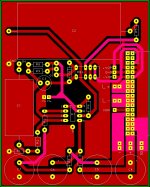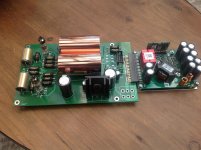Sneak preview.
Just missing a view parts.
Material cost one channel with obbligato and amtrans about €100, With standard parts about €50 a channel.
Just missing a view parts.
Material cost one channel with obbligato and amtrans about €100, With standard parts about €50 a channel.
Attachments
Last edited:
Thank you for sharing, any spare PCB's you'd be happy to sell?
Any subjective feedback vs a SS driver?
Any subjective feedback vs a SS driver?
No spares but ordering 5 pcb's at jlcpcb is just €13 with shipping.
The unbalanced version sounds much like the eval board with little nuances different. Less analytic, different staging,
For the balanced version you must wait until i have all the parts. I also shall measure freqency respons, phase shift and distorsion of the two versions.
The unbalanced version sounds much like the eval board with little nuances different. Less analytic, different staging,
For the balanced version you must wait until i have all the parts. I also shall measure freqency respons, phase shift and distorsion of the two versions.
Hi! Any update on your findings? I’m keen on what you are doing. I too like to order if you have any PCB left.
Thanks
Thanks
... The unbalanced version sounds much like the eval board with little nuances different. Less analytic, different staging ...
This looks like a great project! I've never spent much time with tubes but it has been on my bucket list for quite a while.
Now that I have gotten older, I need to do this now while I still have reasonably good hearing. I will be ordering the parts this afternoon.
Thank you for your contribution.
How is the 63/-63 V plate supply referenced to ground ?
Which plate currents are expected for the circuits in post
1 and 2 ? Thanks.
Which plate currents are expected for the circuits in post
1 and 2 ? Thanks.
R3 won't like 60 or so volts across it while the valve slowly dies!
Using 0volts to reference the control grid is not good.
Using 0volts to reference the control grid is not good.
Using with the Hype NC500 OEM module
Anybody here know what needs to be changed and\or added so as to work with Hypex NC500 OEM modules?
Anybody here know what needs to be changed and\or added so as to work with Hypex NC500 OEM modules?
I don't know anything about your setup (maybe a stellar idea to post it?) but if you got problems, it's likely because of the common grounds and/or your power supply.
Looks like the output prior to the coupling cap is near 0Volts DC. If you used an opamp servo you could eliminate the coupling cap. This would require a relay or solid state switch to protect the output from DC.
I've been building balanced tube preamps with direct coupled outputs since 1989. I can tell you that they do benefit from getting rid of the coupling cap and a good class D module has plenty of resolution to hear the improvement.
I've been building balanced tube preamps with direct coupled outputs since 1989. I can tell you that they do benefit from getting rid of the coupling cap and a good class D module has plenty of resolution to hear the improvement.
Looks like the output prior to the coupling cap is near 0Volts DC. If you used an opamp servo you could eliminate the coupling cap. This would require a relay or solid state switch to protect the output from DC.
I can confirm, the SQ often increased drastically when you drop the input capacitor. If you do not want to change an existing amplifier, it's often also a great improvement if you swap the input C to a better quality one. The improvement on LM3886 amps by removing the input capacitor and adding a DC servo was phenomenal. On many Class D amps the DC servo isn't possible though because of how the amplifier ICs work, that means the suggestion can maybe improve some amps but does not apply to all.
I've been building balanced tube preamps with direct coupled outputs since 1989. I can tell you that they do benefit from getting rid of the coupling cap and a good class D module has plenty of resolution to hear the improvement.
The removal of the input C got some considerable and effective improvements on a lot of amps but (unless you've add a DC servo or adjust the bias on P/P precisely) can also be dangerous because of the DC offset, which may fry your speakers but can also overload the output transformer (not sure if that's the correct term, not a native speaker, sry).
No spares but ordering 5 pcb's at jlcpcb is just €13 with shipping.
The unbalanced version sounds much like the eval board with little nuances different. Less analytic, different staging,
For the balanced version you must wait until i have all the parts. I also shall measure freqency respons, phase shift and distorsion of the two versions.
Anything new to share with us?
Actually I was referring to the output coupling cap(s). I've been running a tube preamp that has a direct-coupled balanced output, using a servo control to maintain 0 Volts DC Offset at the output. During warmup some DC voltages are generated until the tube warms sufficiently to pay attention to the control voltages generated by the servo. But these voltages tend to be low and my class D amp (which also has an input servo to deal with DC offsets at its input) has no troubles with it. So it presents no danger to my speakers if I start up the amps before the preamp.I can confirm, the SQ often increased drastically when you drop the input capacitor. If you do not want to change an existing amplifier, it's often also a great improvement if you swap the input C to a better quality one. The improvement on LM3886 amps by removing the input capacitor and adding a DC servo was phenomenal. On many Class D amps the DC servo isn't possible though because of how the amplifier ICs work, that means the suggestion can maybe improve some amps but does not apply to all.
The removal of the input C got some considerable and effective improvements on a lot of amps but (unless you've add a DC servo or adjust the bias on P/P precisely) can also be dangerous because of the DC offset, which may fry your speakers but can also overload the output transformer (not sure if that's the correct term, not a native speaker, sry).
Question to the moderator gentlemen : you can remove any post, but the
notification is still in our email register and we can read what has just been
posted.
"Somebody" here said goodbye and we see him "banned" now. Maybe the
same will happen to me after this post ?
Now, where can I read about the regulations and the meaning of "banned".
What behaviour will lead to be banned, and how can we avoid it, swimming
in the main stream ?
I also wonder about the meaning of "account suspended" or "on hiatus" and
have no idea where I can learn about this. Not everybody is a clever native
speaker here.
My impression is that there are some "important" or prominent members,
say scientists and so on treated in this way and we can not know why ..
notification is still in our email register and we can read what has just been
posted.
"Somebody" here said goodbye and we see him "banned" now. Maybe the
same will happen to me after this post ?
Now, where can I read about the regulations and the meaning of "banned".
What behaviour will lead to be banned, and how can we avoid it, swimming
in the main stream ?
I also wonder about the meaning of "account suspended" or "on hiatus" and
have no idea where I can learn about this. Not everybody is a clever native
speaker here.
My impression is that there are some "important" or prominent members,
say scientists and so on treated in this way and we can not know why ..
He spammed multiple topics with the same message. I honestly don't know why he kept saying he was bullied.
"Very sad to see him gone ...'
The same here. Koifarm has been nothing but helpful to me on and off this forum. Dare I say, that banning him was a reactionary mistake?
The same here. Koifarm has been nothing but helpful to me on and off this forum. Dare I say, that banning him was a reactionary mistake?
- Home
- Amplifiers
- Class D
- 6N28/6H28 tube balanced preamp for Purify



